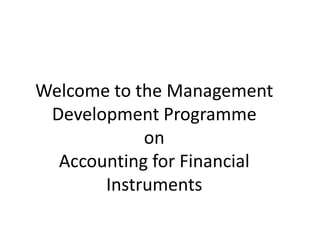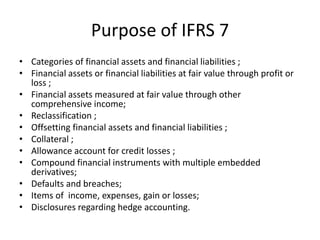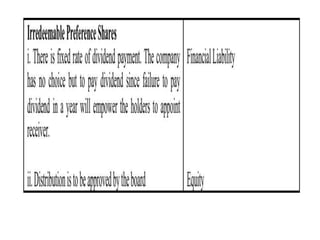Yes, an advance payment to acquire debentures of another entity or government T-bills would be classified as a financial asset. This is because the advance payment represents a contractual right to receive the debentures or T-bills in the future, and debentures and T-bills are considered financial assets. So the advance payment itself meets the definition of a financial asset.

![Accounting for Financial Instruments
Session 1 : Introduction to Financial Instruments [
9.30 – 11.00 AM]
• Introduction to financial instruments standards
• Definition of financial instruments
• Definition of financial asset, financial liability and
equity
• Puttable Instruments as equity
• Obligation for pro-rata distribution in liquidation as
equity
• Financial Guarantee](https://image.slidesharecdn.com/session1-130218005746-phpapp01/85/Financial-Instruments-2-320.jpg)
![Accounting for Financial Instruments
Session 2 Financial Assets & Financial Liabilities
[ 11.00 – 12.00 hrs]
• Classification of financial assets and financial liabilities
• Measurement of financial assets and liabilities at initial
recognition and subsequent measurement
• Fair value measurement issues
• Amortised cost accounting
• Reclassification
• Derecognition](https://image.slidesharecdn.com/session1-130218005746-phpapp01/85/Financial-Instruments-3-320.jpg)
![Accounting for Financial Instruments
• Session 3 : Compound financial Instruments &
Embedded Derivatives
[ 12.00-13.00 hrs]
• Separation of Convertible Debentures
• Separation of embedded derivatives](https://image.slidesharecdn.com/session1-130218005746-phpapp01/85/Financial-Instruments-4-320.jpg)
![Accounting for Financial Instruments
• Session 4 Hedge Accounting
[ 14.00 – 15.30 hrs & 15.45- 17.00 hrs]
Hedged item
Hedging Instruments
Hedging relationships
Fair value hedge , cash flow hedge and hedging
net investment in foreign operations](https://image.slidesharecdn.com/session1-130218005746-phpapp01/85/Financial-Instruments-5-320.jpg)
![Accounting for Financial Instruments
• Session 5 : Financial Instruments : Disclosures
[ 17.00- 17.30 hrs]](https://image.slidesharecdn.com/session1-130218005746-phpapp01/85/Financial-Instruments-6-320.jpg)
![Accounting for Financial Instruments
Session 1 : Introduction to Financial Instruments [
9.30 – 11.00 AM]
• Introduction to financial instruments
standards
• Definition of financial instruments
• Definition of financial asset, financial liability and
equity
• Puttable Instruments as equity
• Obligation for pro-rata distribution in liquidation as
equity](https://image.slidesharecdn.com/session1-130218005746-phpapp01/85/Financial-Instruments-7-320.jpg)







![Accounting standards in India
• In India , the following standards were issued:
AS 30 Financial Instruments : Recognition &
Measurement [Equivalent to IAS 39]
AS 31 Financial Instruments : Presentation [
Equivalent to IAS 32]
AS 32 Financial Instruments : Disclosures [
Equivalent to IFRS 7]
Application of these standards are deferred.](https://image.slidesharecdn.com/session1-130218005746-phpapp01/85/Financial-Instruments-15-320.jpg)
![Accounting standards in India
• The following standards were issued in the
process of IFRS convergence:
Ind-AS 39 Financial Instruments : Recognition &
Measurement [Equivalent to IAS 39]
Ind-AS 32 Financial Instruments : Presentation [
Equivalent to IAS 32]
Ind-AS 107 Financial Instruments : Disclosures [
Equivalent to IFRS 7]
India has to initiate the process of upgrading Ind-AS
39 to Ind-AS 109 in the line of the developments of
IFRS.](https://image.slidesharecdn.com/session1-130218005746-phpapp01/85/Financial-Instruments-16-320.jpg)




![Accounting for Financial Instruments
Session 1 : Introduction to Financial Instruments [
9.30 – 11.00 AM]
• Introduction to financial instruments standards
• Definition of financial instruments
• Definition of financial asset, financial liability and
equity
• Puttable Instruments as equity
• Obligation for pro-rata distribution in liquidation as
equity](https://image.slidesharecdn.com/session1-130218005746-phpapp01/85/Financial-Instruments-21-320.jpg)




![Accounting for Financial Instruments
Session 1 : Introduction to Financial Instruments [
9.30 – 11.00 AM]
• Introduction to financial instruments standards
• Definition of financial instruments
• Definition of financial asset, financial
liability and equity
• Puttable Instruments as equity
• Obligation for pro-rata distribution in liquidation as
equity](https://image.slidesharecdn.com/session1-130218005746-phpapp01/85/Financial-Instruments-26-320.jpg)




![Equity Instruments…
• No contractual obligation condition : To be classified as
equity , the instrument includes no contractual
obligation:
(i) to deliver cash or another financial asset to another
entity; or
(ii) to exchange financial assets or financial liabilities
with another entity under conditions that are potentially
unfavourable to the issuer. [ Paragrph 16(a), IAS32]
• An instrument that contains contractual dividend
clause, repayment clause or put option to the holder is
not an equity instrument.](https://image.slidesharecdn.com/session1-130218005746-phpapp01/85/Financial-Instruments-31-320.jpg)
![Equity Instruments…
Settlement of contract in fixed number of entity’s
equity : In case an instrument will or may be
settled in the issuer’s own equity instruments, and
it is :
(i) a non-derivative that includes no contractual
obligation for the issuer to deliver a variable
number of its own equity instruments; or
(ii) a derivative that will be settled only by the
issuer exchanging a fixed amount of cash or another
financial asset for a fixed number of its own equity
instruments. [Paragraph 16 (b), IAS 32].](https://image.slidesharecdn.com/session1-130218005746-phpapp01/85/Financial-Instruments-32-320.jpg)


![Solution to Case Analysis 1
• A commodity derivative contract that contains
a net settlement caluse is a financial
instrument. Derivative with a positive value is
financial asset. Under the contract, the
carrying amount of the financial asset was
Rs. 10,000 [ 100×(6600-6500)].](https://image.slidesharecdn.com/session1-130218005746-phpapp01/85/Financial-Instruments-35-320.jpg)
![Financial Asset
• [ Advance payment to buy financial asset] Is
advance payment to acquire debentures of
another entity or Government T-Bills or equity
shares / preferences of another entity is a
financial asset?
• Analysis : Yes. Under Paragraph 11 ( c) (ii) of IAS
32 , advance payment signifies a contractual
right of the entity to receive a financial asset , so
it is a financial asset.](https://image.slidesharecdn.com/session1-130218005746-phpapp01/85/Financial-Instruments-36-320.jpg)
![Case Analysis 2
• [ Contractual right to receive cash or another financial asset from another entity
- Investment in perpetual debt ]
Akash Investment Ltd. invested in 8% Perpetual debt of face value Rs. 10,000 issued
by Delhi Auto Ltd. . How should this instrument be evaluated as an item of financial
asset ?
Analysis : This instrument gives a contractual right to the holder ( Akash Investment)
to get a perpetuity of Rs. 800. It is measured in terms of present value applying
current market yield. Assuming current market yield of that type of perpetual debt
instrument is 7% , then it is valued at -
Rs. 800
------------- = Rs. 11,429.
7%
Similarly for Delhi Auto Ltd. it is a financial liability.](https://image.slidesharecdn.com/session1-130218005746-phpapp01/85/Financial-Instruments-37-320.jpg)














![Case Analysis 7
• [ Shares used as currency]
• Entity A issues a debt instrument for which it
receives Rs. 100,000. Under the terms of the
issue, Entity A will repay the debt in 3 years time
by delivering ordinary shares to the value of Rs.
145,000. Should this instrument be classified as
equity ?
• Solution : Entity A is using its own shares as
currency, and the instrument should therefore be
classified as a financial liability.](https://image.slidesharecdn.com/session1-130218005746-phpapp01/85/Financial-Instruments-52-320.jpg)
![Case Analysis 8
• [ Shares to the value of a commodity]
• Entity B issues preference shares for Rs. 1,00,000. The
shares pay no dividend and will be settled in three years
time by Entity A delivering a number of its own ordinary
shares (which are correctly classified as equity) as are equal
to the value of 100 ounces of gold. Can the preference
shares be classified as equity under the fixed for fixed test?
• Solution : No. The shares must be classified as financial
liabilities as the delivery of ordinary shares to the value of
100 ounces of gold represents an amount that fluctuates in
part or in full in response to changes in a variable other
than the market price of the entity's own equity
instruments. [ IAS 32.21].](https://image.slidesharecdn.com/session1-130218005746-phpapp01/85/Financial-Instruments-53-320.jpg)


![Accounting for Financial Instruments
Session 1 : Introduction to Financial Instruments [
9.30 – 11.00 AM]
• Introduction to financial instruments standards
• Definition of financial instruments
• Definition of financial asset, financial liability and
equity
• Puttable Instruments as equity
• Obligation for pro-rata distribution in
liquidation as equity](https://image.slidesharecdn.com/session1-130218005746-phpapp01/85/Financial-Instruments-56-320.jpg)






![Instrument specific conditions
[ Paragraph 16 C, IAS 32]
i. The holder of the instrument is entitled to a pro rata share of the entity’s net assets
in the event of the entity’s liquidation. The entity’s net assets are those assets that
remain after deducting all other claims on its assets.
Net assets in event of entity’s liquidation
A pro-rata share in net asset per unit = ------------------------------------------------------
No of shares / units outstanding
This is multiplied by the number of units which a holder possesses.
ii. The instrument is sub-ordinated to all other classes of instrument. It has no prior
claim on the assets of the issuer on liquidation before any other category of
instrument nor it is to be converted to reach the status of sub-ordinated instrument.
iii. All instrument belonging to this class must have an identical contractual obligation
for the issuing entity to deliver a pro rata share of its net assets on liquidation.](https://image.slidesharecdn.com/session1-130218005746-phpapp01/85/Financial-Instruments-63-320.jpg)
![Issuer specific Conditions
[ Paragraph 16D , IAS 32]
i. The issuer has no other financial instrument which has
expected cash flow that can be attributable to the
instrument over its life are – (a) profit or loss , (b) change
in recognised net assets and (c) fair value change in
recognised and unrecognised net asset of the entity; and
ii The issuer has no other financial instrument which has
the effect of substantially restricting or fixing the residual
return to the e instrument holders.
In case the entity cannot carry the tests under Paragraph
16D , the instrument having obligation to pro-rata
distribution is classified a financial liability.](https://image.slidesharecdn.com/session1-130218005746-phpapp01/85/Financial-Instruments-64-320.jpg)

![Accounting for Financial Instruments
Session 1 : Introduction to Financial Instruments [
9.30 – 11.00 AM]
• Introduction to financial instruments standards
• Definition of financial instruments
• Definition of financial asset, financial liability and
equity
• Puttable Instruments as equity
• Obligation for pro-rata distribution in liquidation as
equity
• Financial Guarantee](https://image.slidesharecdn.com/session1-130218005746-phpapp01/85/Financial-Instruments-66-320.jpg)





